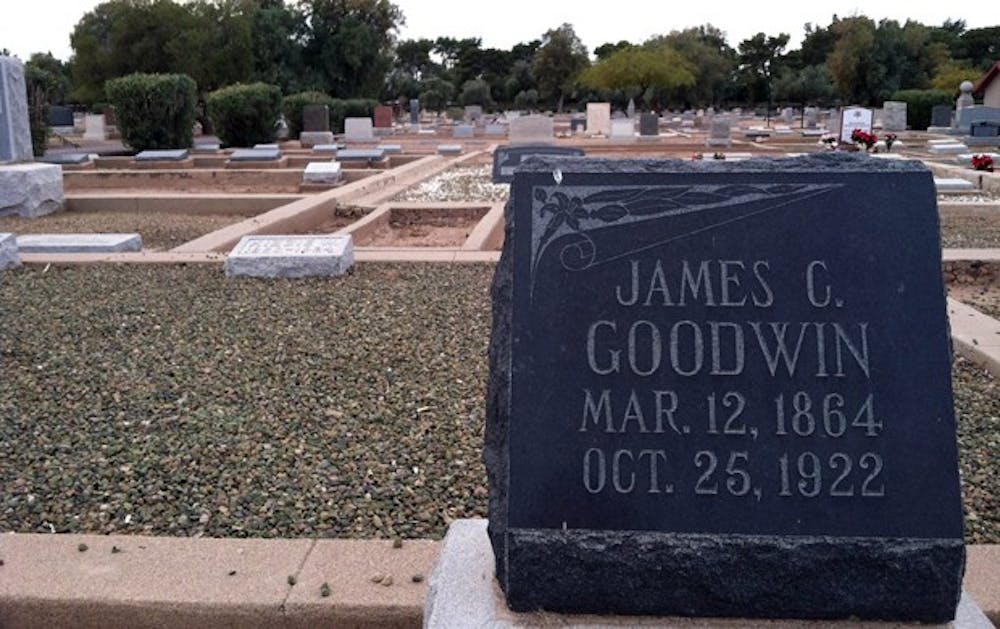The state of Arizona has a big feat to conquer today: blowing out 100 flickering flames on its birthday cake.
While leaping into our second century will bring celebrations today, perhaps we're inclined to peer into the past.
Set the time machine for 1888: a time of settlement and courage, when only a few occupied the region that is now Tempe. This is when the Tempe Double Butte Cemetery opened, says Shirley Blanton, a local historian. There is some dispute on the actual date the cemetery was signed into incorporation, but it was started on land reportedly donated by Neils Peterson, a prominent local farmer and entrepreneur.
Here, in this plot of land located on the southeast corner of 48th Street and Broadway Road, rest noteworthy individuals from Tempe’s past. Many, if not all, played a key role in making the town and surrounding areas what they are today.
The late Arizona Governor Howard Pyle referred to the cemetery as “Tempe’s Arlington” because of the prominence of those buried there. Now, former Gov. Pyle is there as well.
“Everyone out there has a story,” says Cynthia Yanez, an employee of the cemetery.
While all of the cemetery’s occupants are important and all have a story, there are a few who stand out.
The who’s who of Tempe is buried at Double Butte, Jared Smith, the history curator at the Tempe History Museum says.
Before Tempe was Tempe, it was divided into barrios, one of which took the name Hayden’s Ferry. The name Hayden came from Charles Trumbull Hayden, who is known as the “father of Tempe,” Smith says.
Charles Hayden began a ferry service across the Salt River when he settled here in the late 1800s — hence the aquatic appellation. He also built the small flourmill that can be seen at the end of the now hip, bustling street, Mill Avenue.
Then, in 1885, a school was placed in Tempe in large thanks to his advocating, called Territorial Normal School. This school later grew to become the now sprawling Arizona State University, according to cemetery documents.
Charles Hayden also had a son by the name of Carl Trumbull Hayden, or U.S. Sen. Carl Hayden for that matter.
Sen. Hayden served from 1927 to 1969. He played a key role in creating the Central Arizona Project, Grand Canyon National Park and Boulder Dam (now known as the Hoover Dam), according to cemetery documents and Smith. All three of these contributions not only affected Tempe, but the whole state of Arizona.
A huge symbol of Arizona is its flag, as it goes for any other state as well. Many state organizations incorporate its layout and colors into their logos and colors as well, but who thought to make it in the first place?
In the early 1900s, Sen. Hayden was participating on the Arizona Rifle Team in Ohio. At the event, every team needed their own flag to show who they represented. So Nan Hayden, Sen. Hayden’s wife, sewed the first Arizona state flag in a tent she was staying in with her husband, according to cemetery documents and Blanton. The flag became official in 1917.
The Hayden family has their own section in an older portion of Double Butte. This portion is desert dirt spotted with older decaying headstones. They lay in the same ground they helped to establish while living.
But the Haydens, of course, aren't the only prominent family buried there.
Many know the sea of gold migrating across campus to one spot during the fall heralds the coming of a football game at Sun Devil Stadium. But before it was Sun Devil Stadium, it was Goodwin Stadium, named after the family who designed and built it, Smith says.
The Goodwins are well-known for their architecture, but one of the first of them, James C. Goodwin, served in Teddy Roosevelt’s Rough Riders. He's also responsible for the first rail line link to the Tempe and Phoenix area, cemetery documents say.
The Goodwins also have a plot at Double Butte.
For those who dare attend, have no fear: only some say the cemetery is haunted, Smith says.
The only recorded paranormal encounter was from a TEMPO magazine (yep: spelled like that) article from 1974. In the article, the then caretaker of the cemetery, Jim Weldon, reported people meddling around the maintenance building. When he asked them what they were doing, they were shocked to see Weldon outside of the building. The visitors said they had heard cackling coming from within and thought it to be Weldon.
While spooky to some and inspiring to others, for a lot of Arizonans, the cemetery is a home to loved ones. The headstones are engraved with the names and blessings of family members. Olive trees tower over and provide shade to wilting flowers placed by crosses. While somberness looms in a setting like this, all of those who lie here played a role in constructing the community, city and state that is now celebrating its centennial.
For those who want to learn more about the people who are buried there and their accomplishments, the cemetery orchestrates tours for the public. The next one is on March 4 at 2 p.m., for $15 a person.
Contact the reporter at kbiggers@asu.edu







